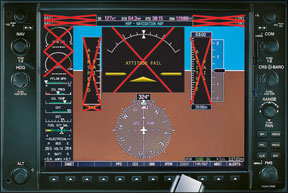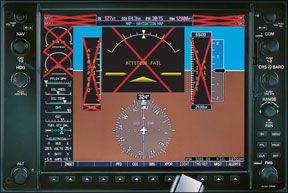Modern “glass panel” avionics give pilots an unparalleled level of situational awareness. But what happens when a hardware or software failure, a sensing issue or a total electrical outage takes away that awareness? Which capabilities remain and which dont? How can instructors present failure modes with maximum realism to prepare pilots for real-world failures?
There are three distinct failure modes resulting in partial panel flight in glass cockpit airplanes:
1. Hardware failure of the Primary Flight Display (PFD);
2. Attitude Heading Reference System (AHRS) or Air Data Computer (ADC) failure rendering part or all flight instrument data unavailable;
3. Total electrical failure or system outage.
Lets look at each in turn, including causes of the failure, what partial panel capabilities remain, and how experienced instructors present the failure mode in training.
PFD Hardware Failure

288
This is the failure mode that seems to take up most time in training, and most of the sales and marketing attention when discussing partial panel scenarios. Failure of the PFD “box,” or interruption of the power that supplies it, results in a blank screen in front of the pilot (not even a “blue screen of death”). Typical two-tube installations (a PFD in front of the pilot, with a Multifunction Display, or MFD, in the center of the panel) automatically jump the PFD picture to the MFD as soon as the failure is detected. This is called the reversionary mode, because the MFD automatically reverts to a PFD. In early glass panel installations the pilot may have to manually select the reversionary mode, and the option may be pilot-commanded at any time, even in airplanes with automatic reversionary mode selection.
Most turbine airplanes have three-screen panels, with a PFD for both front seats. In the event the pilots-side PFD dies he/she is expected to continue using the PFD on the other side of the airplane, although the option of manually selecting PFD information on the center screen always exists as well.
Pilots brought up flying traditional round-gauge IFR might not even consider the reversionary mode to be “partial panel” at all.
This valuable feature makes partial panel flying easy…if the partial panel results from failure of the PFD hardware. Because it is an important advance in ease of flight in the case of primary flight instrument failure (i.e., those directly in front of the pilot), it gets top billing as a safety advantage of glass cockpit airplanes. Except for a little parallax (viewing the instrument from the side, not head-on) everything is exactly as it normally appears for the partial-panel flyer, and all functions (including the autopilot) remain fully operable.
The biggest difference is that large-scale moving map, engine and fuel management, checklists, charts and other functions are relegated to a small window in the corner of the most recent-model MFDs when in reversionary mode, and are not available at all in some earlier installations. Pilots who grow too dependent on these functions, or who eschew paper checklists and navigational charts in favor of electronic versions on the “big screen” will find themselves outside their comfort zones in the event of a PFD hardware failure.
AHRS/ADC Failure
Primary flight information to the PFD (or MFD in reversionary mode) comes from two sources: the Attitude/Heading Reference System (AHRS) and the Air Data Computer (ADC). The AHRS provides attitude information while the ADC gives data like airspeed, altitude and vertical speed. In all glass cockpit piston-engine airplanes except the Cirrus Perspective there is but a single AHRS and ADC on board. The newest Cirrus variant and most turbine aircraft have multiple, redundant systems to make in-flight loss of PFD information extremely unlikely (but not impossible).
For single-AHRS airplanes, though, a system fault or failure will remove some or all of the flight information from either panel screen. This is the famous “Red X” scenario, named because the PFD places a graphic red X over those portions of the display that are not usable or reliable. Depending on the nature of the failure, the pilot may still be able to use certain portions of the display, and incorporate analog (“round-gauge”) instruments-the attitude indicator, altimeter and airspeed indicator-in a partial panel scan.
Success comes from practice in this technique, and in part from the panel placement of standby instruments. Some glass cockpit airplanes have backup instruments well placed to incorporate in a partial panel scan, such as Pipers placement (just to the left of the PFD) and Diamond Aircrafts (top center of the panel). Cirruss placement, below the PFD on a lower subpanel is convenient, but some instructors report this requires “head-bobbing” up and down that may induce vertigo. Mooney and Hawker Beechcraft install the backups on the far right side of the instrument panel, a challenging location if the pilot is trying to combine their indications with those remaining on the PFD.
Other conditions besides AHRS/ADC failure may affect their output. The ADC depends on traditional pitot/static input. Ram a bug into the pitot tube in flight and the red X obscures the PFD airspeed indication, but it also takes out the round-gauge ASI as well. Get a little ice over the static ports and youll lose all altitude indication; airspeed indications may be inaccurate, also-youll need to open the alternate static port and make altitude calibration corrections as needed.
Total Electrical Failure
The most catastrophic partial panel scenario comes from a total electrical failure in flight. With redundant electrical busses and multiple batteries its unlikely, but not impossible, to face a pair of blank screens and be dependent on a round attitude indicator, airspeed indicator and altimeter, with a magnetic compass for direction. But it can happen.
What if youre flying along and smell insulation burning, or see wisps of smoke from the panel? The first step on the Electrical Fire or Overheat checklist is likely to be “Master Switch-OFF.” In traditional-layout airplanes you may have to squint in the dark but, in most cases, youll still have air-driven gyro instruments and pitot-static gauges in your primary scan. In the glass cockpit airplane, youll have to find that information remotely on the panel, in a format you frankly may not be used to interpreting.
Total electrical failure in todays fully integrated glass cockpit airplanes presents another significant challenge. A tenet of partial panel operation is to use known power settings to achieve predictable performance-if you apply a given power and flap/landing gear configuration, the airplane will responded predictably regardless of whether you have a full display in the cockpit or not.
Trouble is, integrated glass cockpit designs display power settings on the PFD or MFD. Lose the displays and you lose the ability to set power precisely. Fly a glass cockpit airplane, or instruct in the type? Get familiar with the physical position of the throttle control for various phases of flight at different altitudes, so youll be able to at least approximate preplanned power settings in case of total electrical failure partial panel.
Taking it a step further, modern design philosophy is trending towards all-electric trim systems, with no means of manually setting trim. In an electrical fire/failure mode not only will you be flying with scant, relatively unfamiliar gauges in a dark cockpit with only a general idea of your power setting, but youll be doing it with a progressively more out-of-trim airplane the farther you diverge from the stage of flight you were in when the failure occurred.
Training for Failure Modes
Glass-savvy instructors I interviewed for this article universally focus on the failed PFD/reversionary mode scenario when providing flight training. This may be because many see it as the most likely partial-panel condition. But the CFIIs I spoke with all admit its mainly because its the easiest instrument failure mode to present in an actual airplane.
Max Trescott, author of the award-winning Max Trescotts CD-ROM Garmin G1000 Course and the FAAs 2008 Flight Instructor of the Year, relates that most manufacturers recommend simply turning the screen brightness down on the PFD until it is not visible and manually putting the MFD in the reversionary mode to train and evaluate partial panel skills. They definitely do not want instructors pulling circuit breakers to simulate failures (the FAA recommends against routinely using push-pull breakers as switches also, says Trescott). This fairly accurately presents the “hardware” failure mode, although without the suddenness and momentary disorientation that might occur if the reversion occurs during an instrument approach or other hard-on-the-gauges (if that term applies to glass cockpit) flying.
Training for the red X scenario is more challenging. Its “simply not realistic” to follow manufactures guidance to dim the display to present this failure mode, according to Trescott. Sportys Pilot Shop, www.sportys.com, sells plastic static cling-type panels with red Xs the instructor can place on the PFD screen, a device Trescott is now using. The only down side, he says, is that many aircraft owners have protective clear plastic laminates on their glass screens, and the Sportys training aid wont stick. In that case, Trescott reverts to the age-old instructors partial panel trick-he slaps a Post-It note over the “failed” portion of the screen.
Speaking of Sportys, Paul Jurgens II is a Master CFI and assistant chief flight instructor for Sportys Academys fleet of single-engine trainers at Batavia, Ohio (he is Chief Instructor for multiengine airplanes and gliders). The Academys Cessnas include glass-cockpit Skyhawks, so Jurgens has a lot of experience teaching behind glass panels. He of course uses the laminate red Xs his employer sells, and notes also that in the event of heading-related PFD failures, there is a big GPS display on the MFD that gives heading, ground track, course deviation and directional trend information-far more than the “whiskey compass” usually available to non-glass partial panel pilots.
Best results come from use of a handheld moving-map GPS, Jurgens says, many of which have a (round-gauge-looking) instrument panel depiction that is surprisingly easy to use as an adjunct to panel gauges in an emergency. Unfortunately, Jurgens suspects very few glass cockpit pilots are using handhelds in the field, perhaps thinking the enormous capability and redundancy of their airplanes renders them immune to in-flight failures.
Paul Gretschel is a Long Island-based CFII specializing in transition training for pilots of glass cockpit Beechcraft. He uses Sportys “red X” clings more often than dimming the PFD, but Gretschel is “more concerned with knowing about the component failure” modes that can take out portions of the flight displays. As for total electrical failure, Gretschel explains, “nothing is written” in most pilots operating handbooks or training guides. Pilots “have to come up with their own” procedures.
Gretschel has attended high-end G1000 simulator training twice, but their instructional philosophy seems to be that pilots “dont need to know anything except the reversionary mode,” that “thats all they [presented] to us in seven days” of simulator training. Clearly there are other potential failures that must be considered and practiced as well.
Whether in glass or round-gauge airplanes, the trick to flying partial panel is to fly toward improving weather so the final portion of the flight can be flown visually. The added capability of glass cockpit airplanes provides significantly more information to the partial panel pilot than most traditional installations, but that information comes with its own challenges. Pilots flying glass cockpit airplanes, and the instructors who train them, must be very familiar with the systems design and operation, practice partial panel often, and consider how theyd respond to a variety of possible partial panel scenarios before faced with a reduction in capability in flight.
Tom Turner is a CFII-MEI who frequently writes and lectures on aviation safety.





The growing number of air travel passengers along leading to the manufacturing of new aircraft is propelling the glass cockpit market.